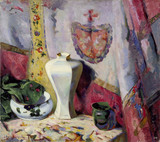Hugh Henry Breckenridge was long associated with Philadelphia as a modernist painter and teacher. From 1887 to 1892 he was a student at the Pennsylvania Academy of the Fine Arts, where he then taught for more than forty years. In 1892 he was awarded a scholarship enabling him to study in Paris at the Académie Julian with William Adolphe Bouguereau (1825-1905) and to travel through Europe, going with the Pennsylvania impressionist Walter E. Schofield (1869-1944). His subsequent landscapes, portraits, and figure paintings reveal the influence of impressionism and an overwhelming fascination with color. His first solo exhibition in 1904 included both paintings and pastels. Breckenridge also produced many commissioned portraits, which provided him with a source of income; these exhibit the dazzling brushwork typical of society portraiture of the period.
A second trip to Europe with Schofield in 1909 made Breckenridge aware of more avant-garde trends. During the 1910s he worked alternately in a vigorous neoimpressionist technique, which he referred to as "tapestry painting," and in a somewhat academic style enriched by an expressionist palette. These paintings gained for him national recognition as a foremost modernist whose art was easily accessible to the public. In 1922 Breckenridge began exhibiting abstract paintings, some of which recall the Improvisations of Wassily Kandinsky (1866-1944). These abstractions of irregularly shaped, colored planes most commonly suggest the nature or the velocity of modern life. Above all they demonstrate his fascination with the theoretical basis of color.
Breckenridge began teaching at the Pennsylvania Academy of the Fine Arts in 1894. During the summer of 1900 he and Thomas Anshutz (1851-1912) established the Darby School of Painting in Darby, Pennsylvania; Breckenridge later established his own school in East Gloucester, Massachusetts. In 1919 he became director of fine arts at the Maryland Institute in Baltimore. In his last years Breckenridge sometimes returned to impressionism, painting landscapes of Gloucester and still-life paintings.
BIBLIOGRAPHY
Dallas, Valley House Gallery, and Dallas, Dorothy Breckenridge Collection, Hugh H. Breckenridge Papers (on microfilm, Archiv. Am. Art) § Arthur Hoeber, "Hugh H. Breckenridge," International Studio 37 (March 1909): xxxiv-xxxvi § Dallas, Valley House Gallery, The Paintings of Hugh H. Breckenridge (1870-1937), exh. cat., 1967, with essay by Margaret Vogel, chronology, lists of collections, awards, and exhibitions § Washington, D.C., Smithsonian Institution, National Collection of Fine Arts, and Philadelphia, Pennsylvania Academy of the Fine Arts, Pennsylvania Academy Moderns, 1910-1940, exh. cat., 1975, published by Smithsonian Institution Press, essays by Joshua C. Taylor and Richard J. Boyle, pp. 14-15 § Gerald L. Carr, "Hugh Henry Breckenridge: A Philadelphia Modernist," American Art Review 4 (May 1978): 92-99,119-25.
